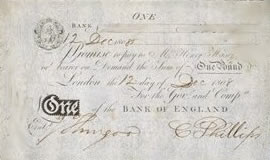Capital
Capital was one of the factors of economic development
There were two major requirements:
- its availability: it was frequently generated by overseas trade and contributed to industrial development in neighbouring areas; banks existed in merchant cities, usually harbours. When not sufficiently available, in industrial regions, industrialists had to find means of financing their activities; they also needed money to pay wages.
- its reliability: new techniques were found to guarantee legal tender against forgeries, for metal and for banknotes ; Benjamin Franklin, who was a printer, adapted the technique of reproducing leaves of plants on paper (invented by the scientist Joseph Breintnall in the1730s) to the watermaking of banknotes, to prevent counterfeiting of currency.
Government policy had to take account of the need for currency. A royal proclamation of 1797 is a response to the development of industry; it states that :
- copper coinage is to be issued to pay the wages of the ’Laborious Poor’
- the value of the coinage will be the intrinsic value of the pieces, ’Workmanship included’: the value of coins had previously been calculated as the value of the metal only; this calculation implies a more complex view including the cost of labour in the total value of goods.
- Matthew Boulton established a mint for copper coinage in his Birmingham factory.
Financial institutions
Cities
Banks in several cities had the right to issue currency.

- Banknote
- An early 19th century banknote from the Bank of England
[click on the picture to enlarge it]
Banks in the capitals - the future central banks:
- London: the Bank of England was founded in 1694 - it managed the national debt; it was frequently dependent on the political situation: it was founded to finance wars, and issued banknotes 18th century when metal became scarce in time of war.
- Edinburgh: the Bank of Scotland was founded in 1695.
As a point of comparison, the Bank of Amsterdam, which lent money to the government of the United Provinces, was founded in 1609; the Bank of Spain, meant both to deal with the government debt and to foster industry and trade, was founded in 1783; the Bank of France was founded in 1800.
Country banks and London banks:
- country banks financed the local agriculture and industry
- London banks invested in the market; they also worked with stockbrokers for long-term loans
- country banks would frequently have partnership with London banks, which acted as agents to deal with the Bank of England (deposit of reserves, buying government stock).
The different types of banks:
- in some counties, merchants and industrialists acted as bankers or founded banks to manage their cash (wages, raw material);
- goldsmiths acted as deposit bankers since they had secure safes; they also acted as money-lenders, using part of the money deposited with them
- attorneys would arrange for lending of money between clients
- merchant banks were founded to finance ventures
Appeals for financing by shareholders:
It was restricted by legislation to avoid disasters such as ’The South Sea Bubble’ (1720); joint-stock companies could be formed
Investment :
- they frequently came from landed families - for instance for the first canals
- some savings went into insurance and friendly societies
- profits were reinvested

